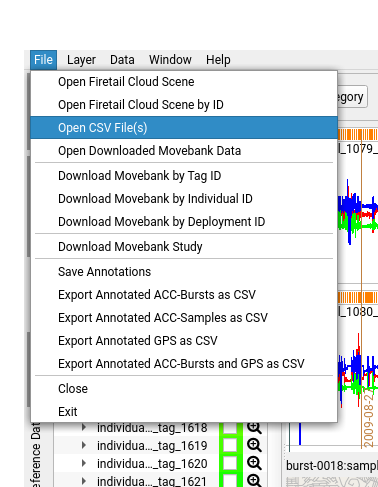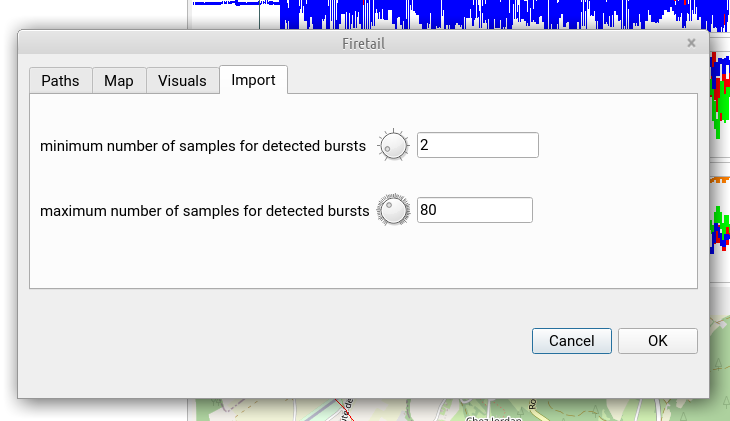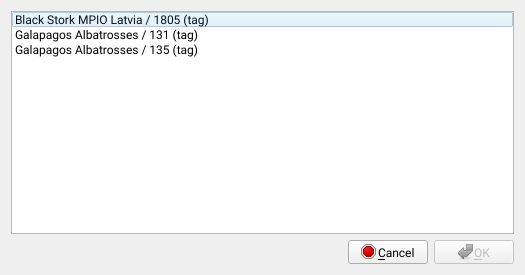Working with local tag data
In most cases, datasets will reside on your local hard drive.
Firetail supports a range of formats to be loaded via the file menu

All datatypes (see below) are accessible via the File > Open CSV... menu.
Note: If you fail to open your tag vendor with Firetail, do not hesitate and contact our support support@firetail.de
When selecting datasets you may also select multiple files at once (shift select). These datasets will be opened in one viewport.
Overview of supported data
| Data Type | origin | contains | common extension | from FT Version |
|---|---|---|---|---|
| GPS | Movebank | lat/lon | -gps.txt | 1 |
| ACC | Movebank | acceleration_x/y/z | -acc.txt | 8 |
| Reference Data | Movebank | categorial/numeric | -reference-data.csv | 4 |
| GPS | e-obs | lat/lon | -gps.txt | 1 |
| ACC | e-obs | bursts | -acc.txt | 1 |
| ECG | e-obs | - | -ecg.txt | 4 |
| Magnetic | e-obs | - | -mag.txt | 3 |
| Quaternion | e-obs | - | -quat.txt | 3 |
| GPS | Ornitela | lat/lon | via Movebank | 5 |
| ACC | Ornitela | gps-coupled/plain | via Movebank | 5 |
| ACC | Ornitela | bursts | Services | 8 |
| GPS | Technosmart | lat/lon | .csv | 5 |
| ACC | Technosmart | gps-coupled/bursts | - | 5 |
| GPS | Vectronic | lat/lon | via Movebank -gps.csv |
8 |
| ACC/Accessory | Vectronic | continuous acc data | via Movebank -accessory.csv |
8 |
| ACC | Vectronic | bursts | Services | 8 |
| ACC Annotations | Firetail | tabular | annotations2.csv | 4 |
Services
We provide data conversion services to adapt your tag data to Movebank/Firetail requirements. Contact us! Full license holders will get detailed expert support to help you get most out of your data. Let us know in case your data does not work as expected
Burst type data vs. continuous recording
Burst data can be counterintuitive. We would like to clarify how burst recording works and how this affects the datasets you are working with.
Many high-res tags record sensor data at a fixed frequency starting at a given timestamp. We refer to this kind of data as burst-type format. In this regard a burst is a ordered set of samples captured for a given amount of time:
| start timestamp | sampling frequency | axes | burst data |
|---|---|---|---|
| 17:08:13.000 | 40 | XYZ | recorded triplets |
This example data has a fixed resolution, here 40Hz. This frequency is usually much higher than the GPS frequency (1Hz and below). By contrast, continuous formats commonly use a single line of data for each recorded value, which can result in data redundancy, in particular for Movebank downloads at the time of writing this documentation.
Few devices continuously record high-res data. When provided as accessory data, Firetail will convert this data to bursts, e.g. to enable acceleration annotation on the burst level.
Burst-type formats capture each burst as a single entry (line) in a csv. A header definition is required with at least the following fields to define each burst:
- start-timestamp: burst starts here
- acceleration-axes: one/two/three distinct characters (X, Y, Z) stating the the order of axes in the burst, usually X, XY or XYZ
- acceleration-frequency-per-axis: frequency in Hz
- accelerations-raw: consecutive singletons, 1-tuples, 2-tuples or triplets (depending on the type of acceleration axes)
The spacing of samples is uniquely given by the start timestamp and the axis frequency. To improve the overview when working with bursts, Firetail shows bursts consecutively without time gaps. The cursor will wait between non-consecutive bursts during replay.
Automated Burst Detection
Motivation: Firetail can efficiently handle acceleration burst data. FireSOM and manual annotation procedures benefit from a burst level perspective.
Therefore, Firetail features automated burst detection and conversion for continuously recorded events like Ornitela or Vectronic. In File > Settings > Import two parameters control the length of detected bursts:
- Minimum number of samples for detected bursts: filter all bursts that are shorter than the given amount of samples after detection (default
2). - Maximim number of samples for detected bursts: split bursts that exceed the number of bursts after detection (default
80).

The default settings depend on the source frequency, but may make sense for a wide range of data:
- 1Hz data is split into chunks of
1 min 20 sec, singleton samples are filtered - 8Hz data is split into chunks of
10 sec, singleton samples are filtered - 40Hz data is split into chunks of
2 sec, singleton samples are filtered
Caveat: extreme settings may filter all bursts
These settings affect the import procedure, open data must be re-opened.
E-OBS Datasets
Tags by e-obs offer state-of-the-art solutions to animal tracking. Data gathered from these tags can be imported directly into Firetail using File > Open CSV Files.
E-obs and related modern tags feature a wide range of sensor data (see Event data) that Firetail can show fully synchronized.
Given data from an IMU (inertial measurement unit) is present, Firetail offers a visualization option to show the spatial orientation of the e-obs tracking device.
See also Acceleration Data.
Technosmart Datasets
Some of the most widespread Technosmart tags are supported in terms of acceleration and GPS and event data:
- Axy-Trek
- Axy-5
Ornitela Datasets
Firetail can handle Ornitela location data, acceleration data and events. Currently, the Onitela ‘SENSORS’ are not supported by Movebank (work in progress), yet Ornitela data can be loaded locally. Automated burst detection will apply.
Ornitela users can actively monitor their Movebank data feeds from within Firetail and benefit from retrieving the latest data as an iterative update.
Vectronic acceleration data
Vectronic binv2 is a closed standard and not directly supported in Firetail. A possible workflow to access Vectronic acceleration data from Movebank is to:
- Use the Vectronic
Motion Data Monitor(MDM) to export csv data - Use Movebank to create a custom upload of an
accessory fileusingacceleration_x/y/zcolumns- block-wise correction artifacts in raw MDM data may require filtering duplicates
- exported timestamps may vary with you LOCALE/language settings
- Upload the data along with existing GPS in your project
- Download the data from Firetail using
Download Movebank by deployment/individual/tag
Please notify us, if this workflow does not produce expected results.
Loading Movebank CSV data
Movebank data can be imported directly via our API interface.
Loading local CSVs is possible via File > Open Movebank CSV File.
See also: Movebank data
Previous downloads
Data that has been downloaded previously via the Movebank data can be accessed directly.
- Open
File > Open Downloaded Data. - Choose a dataset, hit
OK

Note that to update your datasets, please use the
Download Movebank byoptions. Previous datasets will use local data only